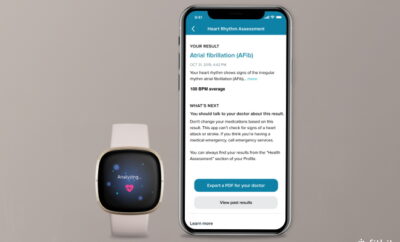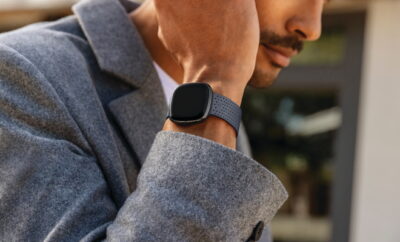
The Gen XY Lifestyle
The Fitbit Inspire 3 – an uncomplicated activity tracker
The Inspire 3 is Fitbit’s latest entry-level health, fitness and activity tracker. It’s not expensive, and tracks all the key metrics you need, such as heart rate, sleep and stress levels.
The new Fitbit Inspire 3 features a screen upgrade, and now sports an AMOLED screen. Metrics on the screen are displayed in colour. It’s website claims an up-to-10-day long battery life, depending on your usage habits.
The tracker sells for SGD `148, comes with 12-months limited warranty and can be ordered online. Colour options include Midnight Zen (dark gray), Morning Glow (orange) and Lilac Bliss (light purple). It can also be purchased at major retail stores such as Amazon, Best Denki, Challenger, Courts, Gain City, Harvey Norman, Lazada and Shopee.
There is an option to top up an additional USD 79.99 (annually) for a Fitbit Premium subscription to use with the tracker. Subscribers can access more features such as Daily Readiness Score, and personalised recommendations.
We have been using testing an Inspire 3 for about a week, and here are the 3 things we like about it so far, and 1 that we are iffy about.
It tracks all the key but basic measurements to give me a sense of what’s going on during activity.
The Inspire 3 tracks calories, counting steps, distance, heart rate, sleep, and various workouts. From the tracker, you can select from over 20 workouts such as cycling, running, swimming, walking as well as those from the gym such as threadmill. I was only able to keep about 6 different workout types in the tracker. The workout types can be swapped though, through the Fitbit app and a re-sync of the tracker.

Similar to other activity trackers, the Inspire 3 tracks how active your workout is, based on your heart rate, age and fitness levels. For Fitbit, this is termed as Active Zone minutes (compared to Garmin where they just call it intensity minutes) and it measures time spent across fat-burning (typically zone 2/zone 3) and cardio zones.
Sleep tracking works, and serves as a reminder to inculcate good sleep habits to get more deep sleep and REM sleep.
I have not used the tracker long enough to establish a proper baseline for sleep tracking. However, despite the short review period, it is already useful in pointing out the duration (how long), periods of (when does it happen during sleep), and consistency of achieving deep sleep and REM sleep.
The tracker also monitors resting heart rate, sleep duration and Sp02 (blood oxygen) levels. For blood oxygen levels, this is throughout the day, as opposed to only during sleep.

I wasn’t able to get it to differentiate between sleep and naps though. This is not a unique challenge to Fitbit but generally across most entry, and middle-level trackers.
Notifications are a double-edged sword on the screen.
The Inspire 3 is not a smartwatch, and therefore shouldn’t be compared to those. What it does do, however, is deliver notifications through Bluetooth from the phone or tablet. It’s quite handy, allowing me to see who’s calling, or to quickly check a text message, and decide whether to pull out the phone.
Now the only issue here, is that the screen space is small. This means that reading the notifications can be challenging for those with less than perfect eyesight, or if the eyes are strained. While it’s great to be able to receive notifications, it might be easier to look at the phone instead when an alert comes in.
Navigating the tracker on the small screen is fine, given the side buttons that either return you to the home screen (clock face) or turns it on. It is probably better to complete a workout and reference the Fitbit app vs. trying to constantly keep checking the tracker screen during the workout.
There is an ‘always-on’ display setting but I imagine this would drain the battery quicker than the 10-day estimate. Again, using the side button to turn it on was quicker, and also helped to conserve battery life.
There was an issue with tracking runs using GPS.
It’s probably useful to know that the Inspire 3 does not come with an in-built GPS.
If you are running outdoors, the tracker can connect with your smartphone and that device’s GPS to record your running route. This is not a deal-breaker, in my opinion, given the pricing of the tracker. Most other similarly-priced trackers do not offer in-built GPS either.
For gym and in-place workouts, the tracker did well and captured the relevant data needed to tell whether I had a good workout, or just good effort.
Other features I am looking forward to trying in the weeks to come.
There is a Smart Wake function that allows you to set an alarm. The tracker will monitor your sleep and try to find the ‘best time’ to wake you up, up to 30 minutes prior to the alarm time that was set. This ‘best time’ will be one where you are in a light period of sleep. According to studies, waking up during such periods can help us feel more rested and refreshed.
While this notification did not come up during the review period, I am looking forward to seeing whether the tracker will send an alert for irregular heart rate (AFib), whether it’s unnaturally low or high. Sometimes, these alerts can be a signal from the body to pay attention to something and have that conversation with a doctor.
The Inspire 3 tracker I tested was provided by Fitbit.
Photo credit to Fitbit.









